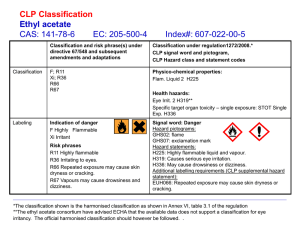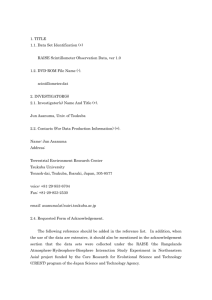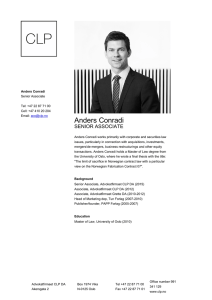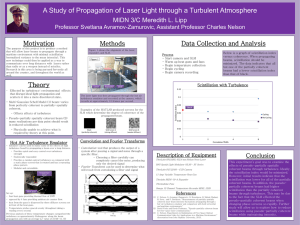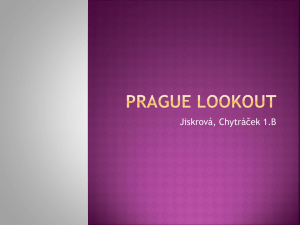2. Definitions - About the journal
advertisement
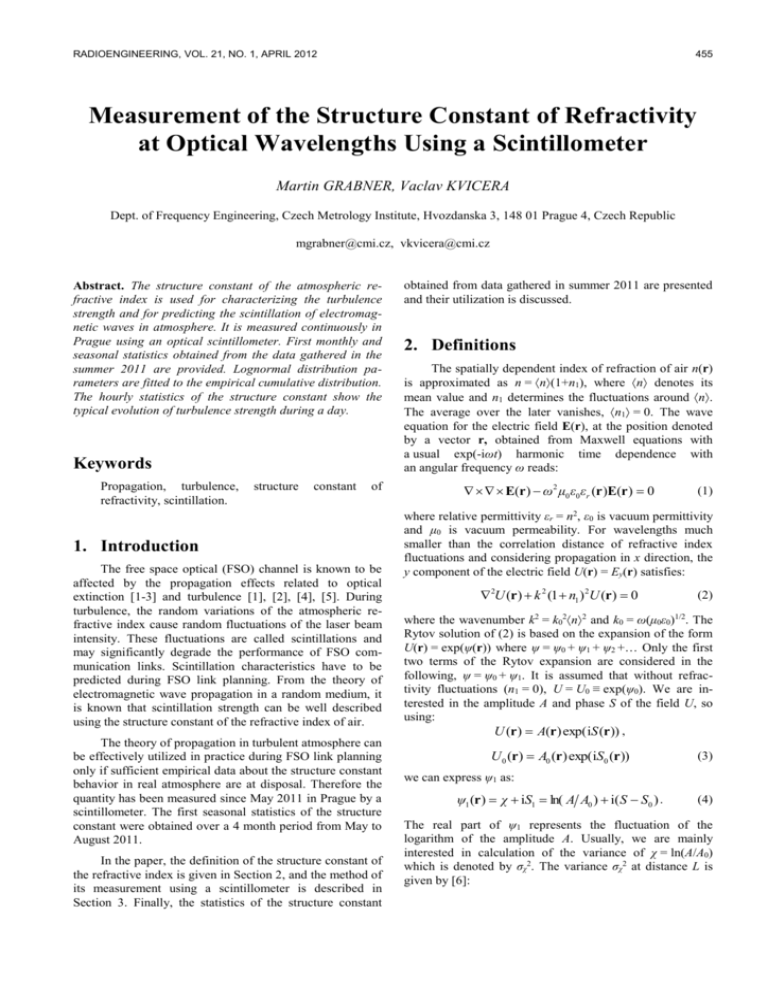
RADIOENGINEERING, VOL. 21, NO. 1, APRIL 2012 455 Measurement of the Structure Constant of Refractivity at Optical Wavelengths Using a Scintillometer Martin GRABNER, Vaclav KVICERA Dept. of Frequency Engineering, Czech Metrology Institute, Hvozdanska 3, 148 01 Prague 4, Czech Republic mgrabner@cmi.cz, vkvicera@cmi.cz Abstract. The structure constant of the atmospheric refractive index is used for characterizing the turbulence strength and for predicting the scintillation of electromagnetic waves in atmosphere. It is measured continuously in Prague using an optical scintillometer. First monthly and seasonal statistics obtained from the data gathered in the summer 2011 are provided. Lognormal distribution parameters are fitted to the empirical cumulative distribution. The hourly statistics of the structure constant show the typical evolution of turbulence strength during a day. Keywords Propagation, turbulence, refractivity, scintillation. structure constant of 1. Introduction The free space optical (FSO) channel is known to be affected by the propagation effects related to optical extinction [1-3] and turbulence [1], [2], [4], [5]. During turbulence, the random variations of the atmospheric refractive index cause random fluctuations of the laser beam intensity. These fluctuations are called scintillations and may significantly degrade the performance of FSO communication links. Scintillation characteristics have to be predicted during FSO link planning. From the theory of electromagnetic wave propagation in a random medium, it is known that scintillation strength can be well described using the structure constant of the refractive index of air. The theory of propagation in turbulent atmosphere can be effectively utilized in practice during FSO link planning only if sufficient empirical data about the structure constant behavior in real atmosphere are at disposal. Therefore the quantity has been measured since May 2011 in Prague by a scintillometer. The first seasonal statistics of the structure constant were obtained over a 4 month period from May to August 2011. In the paper, the definition of the structure constant of the refractive index is given in Section 2, and the method of its measurement using a scintillometer is described in Section 3. Finally, the statistics of the structure constant obtained from data gathered in summer 2011 are presented and their utilization is discussed. 2. Definitions The spatially dependent index of refraction of air n(r) is approximated as n = n(1+n1), where n denotes its mean value and n1 determines the fluctuations around n. The average over the later vanishes, n1 = 0. The wave equation for the electric field E(r), at the position denoted by a vector r, obtained from Maxwell equations with a usual exp(-iωt) harmonic time dependence with an angular frequency ω reads: E(r ) ω2 μ0 ε0 εr (r )E(r ) 0 (1) where relative permittivity εr = n2, ε0 is vacuum permittivity and μ0 is vacuum permeability. For wavelengths much smaller than the correlation distance of refractive index fluctuations and considering propagation in x direction, the y component of the electric field U(r) = Ey(r) satisfies: 2U (r) k 2 (1 n1 ) 2U (r) 0 (2) where the wavenumber k2 = k02n2 and k0 = ω(μ0ε0)1/2. The Rytov solution of (2) is based on the expansion of the form U(r) = exp(ψ(r)) where ψ = ψ0 + ψ1 + ψ2 +… Only the first two terms of the Rytov expansion are considered in the following, ψ = ψ0 + ψ1. It is assumed that without refractivity fluctuations (n1 = 0), U = U0 ≡ exp(ψ0). We are interested in the amplitude A and phase S of the field U, so using: U (r ) A(r ) exp( iS (r )) , U 0 (r) A0 (r) exp( iS0 (r)) (3) we can express ψ1 as: ψ1 (r) χ iS1 ln( A A0 ) i(S S0 ) . (4) The real part of ψ1 represents the fluctuation of the logarithm of the amplitude A. Usually, we are mainly interested in calculation of the variance of χ = ln(A/A0) which is denoted by σχ2. The variance σχ2 at distance L is given by [6]: M. GRABNER, V. KVICERA, MEASUREMENT OF THE STRUCTURE CONSTANT OF REFRACTIVITY … 456 σ 2χ 0.307Cn2k 7 6 L11 6 (5) where Cn2 (m-2/3) is the structure constant of the refractive index of air. The formula (5) is well known (sometimes called Rytov variance) and used very often for an estimation of the scintillation strength. It was derived for a plane wave incident on the layer of turbulent medium and for a point detector. Other more complex formulas valid in different conditions have been derived [6]. In practice, the variance of optical intensity (power density), I ~ A2, expressed in dB2 is often needed. Noting that 10log(I/I0) = 20log(e)χ, such a variance is: σ I2[dB2 ] (20 log e)2 σ 2χ 75.44σ 2χ . (6) The structure constant Cn2, introduced in (5), is defined, using a structure function of refractive index Dn: Dn (r ) n1 (r r0 ) n1 (r0 ) 2 (7) with r0 as the reference position vector, distance r = |r|, by the relation: Dn (r ) Cn2 r 2 3 (8) for l0 r L0 where l0 and L0 are inner and outer scales of turbulent eddies. The conditions l0 < 1 cm and L0 > 10 m can be assumed for an earth atmosphere [6]. intensity, ln I, is estimated to have the normal distribution N(μlnI, σlnI2) with mean μlnI and variance σlnI2. Then the average intensity and its variance can be obtained as [8]: I exp( μln I σln2 I 2) , (9a) σ I2 (exp( σ ln2 I ) 1) I . (9b) 2 From the definition of χ and from (9b) we have: σ 2χ 1 2 1 σ ln I ln( 1 σ I2 4 4 2 I ). (10) Once σχ2 is obtained from (10), the following relation is used to determine the structure constant: σ 2χ 0.223Cn2 D7 3 L3 (11) where D (m) denotes the diameter of the transmitter aperture and L (m) is the path length. Equation (11) is the approximation of a more complex relationship [9] valid when transmitter and receiver apertures are larger than the Fresnel zone, D >> (λL)1/2. An example of the measured time series of the structure constant is shown in Fig. 2. Typically, the structure constant fluctuations are daily quasi-periodic with the lowest values occurring usually at night. 3. Measurement A scintillometer Scintec Boundary Layer Scintillometer BLS450 [7] was installed in Prague in April 2011 on the path between Jablonova Street and the building B of the Czech Metrology Institute in Hvozdanska Street. The path length is about 2.2 km. Fig. 1 shows the BLS450 transmitter and receiver. The scintillometer transmitter aperture consists of 444 LEDs emitting 880 nm light with a beam divergence of 16°. The receiver lens diameter is 140 mm and the field of view is 8 mrad. Fig. 2. The structure constant of the refractivity measured in 1-10 July 2011 in Prague using the scintillometer BLS450. 4. Statistics of Structure Constant Fig. 1. Scintec Boundary Layer Scintillometer BLS450, LED transmitter – right, receiver - left. Light intensity fluctuations caused by atmospheric turbulence are measured by the scintillometer. Specifically, the following statistics are obtained: the average received intensity I and the variance of the received intensity σI2. Since the scintillations are observed to have nearly the lognormal probability distribution, the log-amplitude of the First results were obtained during the measurement period from May to August 2011. Monthly cumulative distributions (CDs) of the structure constant Cn2 for 4 months are depicted in Fig. 3 using a normal probability scale on the vertical axis and a logarithmic scale on the horizontal axis. The CDs can be seen to be very similar in all months processed. The median (50% percentage of time) of Cn2 is between 10-15 and 210-15 m-2/3 and empirical CDs can be estimated as nearly log-normal (straight lines in RADIOENGINEERING, VOL. 21, NO. 1, APRIL 2012 457 this plot type) with slight deviation from log-normality at the largest values of Cn2. Fig. 4. Seasonal empirical cumulative distribution of the structure constant of refractive index of air measured from May to August 2011 in Prague and pertinent lognormal model. Fig. 3. Monthly empirical cumulative distributions of the structure constant of refractive index of air measured from May to August 2011 in Prague. A seasonal CD obtained over the whole 4 month period is shown in Fig. 4. The general trend of the CD is similar as of the monthly CDs presented above. The lognormal model is also shown in the same plot with parameters fitted to the empirical (measured) distribution. The highest difference between the lognormal (LN) model and the empirical CD is seen for the highest values of the structure constant. The LN distribution of Cn2 is described in Fig. 4 by the normal probability density function of the decimal logarithm, A = log10 Cn2: f A (a) (a μ) 2 exp 2σ 2 2πσ 2 1 (12) with the mean μ = -14.8 and the standard deviation σ = 0.5. Thus Cn2 = 10A where A is normally distributed. The structure constant values observed during 4 month period range between 10-17 and 10-13 m-2/3. The question arises whether fluctuations of Cn2 are completely stationary or are somehow related to a particular time during a day. For that purpose, hourly statistics of the structure constant were obtained, see Fig. 5. The figure shows the 1%, 20%, 50%, 80% and 99% percentiles of Cn2 values measured in a given hour. Clearly, the highest values were observed at around noon; on the other hand, the least turbulent atmosphere was at about 5 p.m. Looking at medians only (the “central” points inside the 20%-80% intervals denoted by the bars in Fig. 5), it seems that on average, the atmosphere is more turbulent by day and less turbulent during night. Nevertheless, a significant spread between 1% and 99% percentiles should be noted showing that the extreme values of Cn2 may appear during all the day without too pronounced preference. Fig. 5. Hourly statistics (UTC time) of the structure constant of refractive index of air measured from May to August 2011 in Prague, 1%, 20%, 50% (median), 80% and 99% percentiles. 5. Conclusions The scintillation strength of the optical received power caused by propagation of an optical signal through turbulent atmosphere should be estimated in order to assess the performance of FSO systems. For this purpose, the relationships like (5) and (6) are often used where the structure constant of the refractive index of air Cn2 determines the turbulence strength. In this work, the first monthly and seasonal statistics of Cn2 obtained from scintillometer measurement in Prague were presented. It was demonstrated that the structure constant has nearly lognormal probability distribution and a simple model was proposed. M. GRABNER, V. KVICERA, MEASUREMENT OF THE STRUCTURE CONSTANT OF REFRACTIVITY … 458 The observed ratio of the highest value of Cn2 (~10 m-2/3) and of its mean (~10-15 m-2/3) reached about 100. Considering (5), it would mean that the scintillation variance increases 100 times above its mean value in very turbulent atmospheric conditions. It should be noted however that the theoretical relation in Section 2 is valid for weak fluctuations only. It is known that in the case of strong fluctuations, scintillation becomes saturated such that there is no more linear proportionality between the structure constant Cn2 and the scintillation variance. According to [9], strong turbulence correction [10] is taken into account in the BLS450 scintillometer when estimating the value of the structure constant. -13 It follows from the Rytov variance relation (5) that scintillation is increasing with propagation distance. This is also confirmed by formula (11) which was derived under different conditions. Therefore it seems that the adverse turbulence propagation effects are important mainly on longer FSO paths (with L > 1 km). Nevertheless turbulence effects have been reported on paths shorter than 120 m [11], [12]. Taking into account the fact that scintillation is usually regarded as a stochastic process with a correlation time shorter than 10 seconds (e.g. 1-10 ms assumed in [13]), it remains to be proved by further experiments whether relatively slow power fluctuations observed on those short links [11], [12] are turbulence effects described by the above theory. Acknowledgements This research is supported by the Ministry of Education, Youth and Sports of the Czech Republic under project no. OC09076 in the framework of COST IC0802. References [1] BOUCHET, O., SIZUN, H., BOISROBERT, C., DE FORNEL, F., FAVENNEC, P. Free-Space Optics, Propagation and Communication. 1st ed. London: ISTE, 2006. [2] MAJUMDAR, A. K., RICKLIN, J. C., (Ed.) Free-Space Laser Communications. 1st ed. New York: Springer, 2008. [3] GRABNER, M., KVICERA, V. The wavelength dependent model of extinction in fog and haze for free space optical communication. Optics Express, 2011, vol. 19, p. 3379 - 3386. [4] PROKES, A. Modeling of atmospheric turbulence effect on terrestrial FSO link. Radioengineering, 2009, vol. 18, no. 1, p. 42 to 47. [5] DORDOVA, L., WILFERT, O. Calculation and comparison of turbulence attenuation by different methods. Radioengineering, 2010, vol. 19, no. 1, p. 162 - 167. [6] ISHIMARU, A. Wave Propagation and Scattering in Random Media. 1st reissued. ed. New York: IEEE Press, 1997. [7] http://www.scintec.com/PDFs/BLS450_2010.pdf [8] BUBENÍK, F., PULTAR, M., PULTAROVÁ, I. Mathematical Formulas and Methods. (in Czech), 1st ed. Praha: Nakladatelství ČVUT, 1997. [9] Scintec AG, Germany. Scintec Boundary Layer Scintillometer Hardware Manual, version 2.06, August 2010. [10] CLIFFORD, S. F., OCHS, G. R., LAWRENCE, R. S. Saturation of optical scintillation by strong turbulence. Journal of the Optical Society of America, 1974, vol. 64, no. 2, p. 148 - 154. [11] LIBICH, J., ZVANOVEC, S. Influences of turbulences in near vicinity of buildings on free-space optical links. IET Microwaves, Antennas & Propagation, 2011, vol. 5, no. 9, p. 1039 - 1044. [12] PESEK, J., FISER, O., SVOBODA, J., SCHEJBAL, V. Modeling of 830 nm FSO link attenuation in fog or wind turbulence. Radioengineering, 2010, vol. 19, no. 2, p. 237 - 241. [13] ZHU, X., KHAN, J. M., WANG, J. Mitigation of turbulenceinduced scintillation noise in free-space optical links using temporal-domain detection techniques. IEEE Photonics Technology Letters, 2003, vol. 15, no. 4, p. 623 - 625. About Authors Martin GRABNER was born in Prague in 1976. He graduated from the Czech Technical University in Prague in 2000 (M.S.) and 2008 (Ph.D.). Currently he is working at the Czech Metrology Institute as a researcher in the area of electromagnetic wave propagation in atmosphere. Vaclav KVICERA received the M.S. and Ph.D. degrees in Electrical Engineering from the Czech Technical University in Prague in 1971 and 1986, respectively. He is a senior researcher at the Czech Metrology Institute. His work is aimed at electromagnetic wave propagation in frequency bands of fixed radio and optical links, especially at the influence of hydrometeors in frequency bands above 10 GHz.
